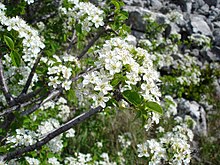Prunus mahaleb
| Prunus mahaleb | |
|---|---|

| |
| Spring flowers of St. Lucie cherry | |
| Scientific classification | |
| Kingdom: | Plantae |
| Clade: | Tracheophytes |
| Clade: | Angiosperms |
| Clade: | Eudicots |
| Clade: | Rosids |
| Order: | Rosales |
| Family: | Rosaceae |
| Genus: | Prunus |
| Species: | P. mahaleb
|
| Binomial name | |
| Prunus mahaleb | |
| Subspecies | |

| |
| Distribution map | |
| Synonyms | |
|
Of the species:[3]
Of subsp. cupaniana:[4]
Of subsp. mahaleb:[5]
| |
Prunus mahaleb, the mahaleb cherry[6] or St Lucie cherry, is a species of cherry tree. The tree is cultivated for a spice obtained from the seeds inside the cherry stones. The seeds have a fragrant smell and have a taste comparable to bitter almonds with cherry notes.
The tree is native to central and southern Europe, Iran and parts of central Asia. It is adjudged to be native in northwestern Europe or at least it is naturalized there.[2][7][8] It is a deciduous tree or large shrub, growing to 2–10 m (rarely up to 12 m) tall with a trunk up to 40 cm diameter.
Description
The tree's
It demonstrates selective fruit abortion, producing a high proportion of excess flowers that result in low fruit set levels. This reduces the number of "poor quality" fruit and increases the viability of its seeds.[11][12]
Subspecies
As of February 2023[update], two subspecies were accepted by Plants of the World Online:[3]
- Prunus mahaleb subsp. cupaniana (Guss.) Arcang. (synonyms include Prunus cupaniana) – restricted to north Sicily[4]
- Prunus mahaleb subsp. mahaleb (synonyms include Prunus odorata) – elsewhere in the native range of the species[5]
Distribution and habitat
Prunus mahaleb occurs in thickets and open woodland on dry slopes; in central Europe at altitudes up to 1,700 m (5,600 ft), and in highlands at 1,200–2,000 m in southern Europe.[10] It has become naturalised in some temperate areas, including Europe north of its native range (north to Great Britain and Sweden), and locally in Australia and the United States.[10][13][14]
Ecology
A scientific study
Cultivation
Away from its native range, the species is grown as an
Uses

The plant is also cultivated for
The
The bark, wood, and seeds contain coumarin.[20][21] They have anti-inflammatory, sedative and vasodilation effects.[citation needed]
The fruit of Prunus mahaleb is inedible.[22]
History
Prunus mahaleb is a likely candidate for the ḫalub-tree mentioned in early Sumerian writings, a durable fruit-bearing hardwood with seeds and leaves known for their medicinal properties and associated with the goddess
References
- ^ Rhodes, L. & Maxted, N. (2016). "Prunus mahaleb". IUCN Red List of Threatened Species. 2016: e.T172121A48416825. Retrieved 24 November 2021.
- ^ a b "Prunus mahaleb". Germplasm Resources Information Network. Agricultural Research Service, United States Department of Agriculture. Retrieved 2008-03-14.
- ^ a b "Prunus mahaleb L..", Plants of the World Online, Royal Botanic Gardens, Kew, retrieved 2023-02-11
- ^ a b "Prunus mahaleb subsp. cupaniana (Guss.) Arcang." Plants of the World Online. Royal Botanic Gardens, Kew. Retrieved 2023-02-11.
- ^ a b "Prunus mahaleb subsp. mahaleb". Plants of the World Online. Royal Botanic Gardens, Kew. Retrieved 2023-02-11.
- ^ USDA, NRCS (n.d.). "Prunus mahaleb". The PLANTS Database (plants.usda.gov). Greensboro, North Carolina: National Plant Data Team. Retrieved 14 October 2015.
- ^ Euro+Med Plantbase Project: Prunus mahaleb Archived 2007-09-28 at the Wayback Machine
- ^ ISBN 0-00-220013-9.
- ^ Flora of NW Europe: Prunus mahaleb Archived 2007-12-15 at the Wayback Machine
- ^ ISBN 0-340-40170-2.
- JSTOR 2445715.
- JSTOR 2445332.
- ^ New South Wales Flora: Prunus mahaleb
- ^ USDA Plants Profile: Prunus mahaleb
- (PDF) from the original on 2020-07-11.
- JSTOR 3545521.
- ISBN 0-7195-2427-X.
- ^ "Mahaleb Cherry | Whitman County | Washington State University".
- ^ a b Gernot Katzer's Spice Pages: Mahaleb Cherry (Prunus mahaleb L.)
- ^ a b Vedel, H., & Lange, J. (1960). Trees and Bushes in Wood and Hedgerow. Metheun & Co. Ltd., London.
- PMID 5440687.
- ISBN 0-394-50760-6.
- ISBN 161451545X.
- ^ "Mahaleb" in Remarques sur les mots français dérivés de l'arabe, by Henri Lammens, year 1890.
- ^ Le livre de l'agriculture, by Ibn al-'Awwam, translated to French J.-J. Clément-Mullet, year 1866, volume II page 367–368.
- ^ "Maaleb" and "mahaleb" in the Pandectarum of Matthaeus Silvaticus (in Latin).
- ^ a b Mahaleb @ CNRTL.fr (in French).

